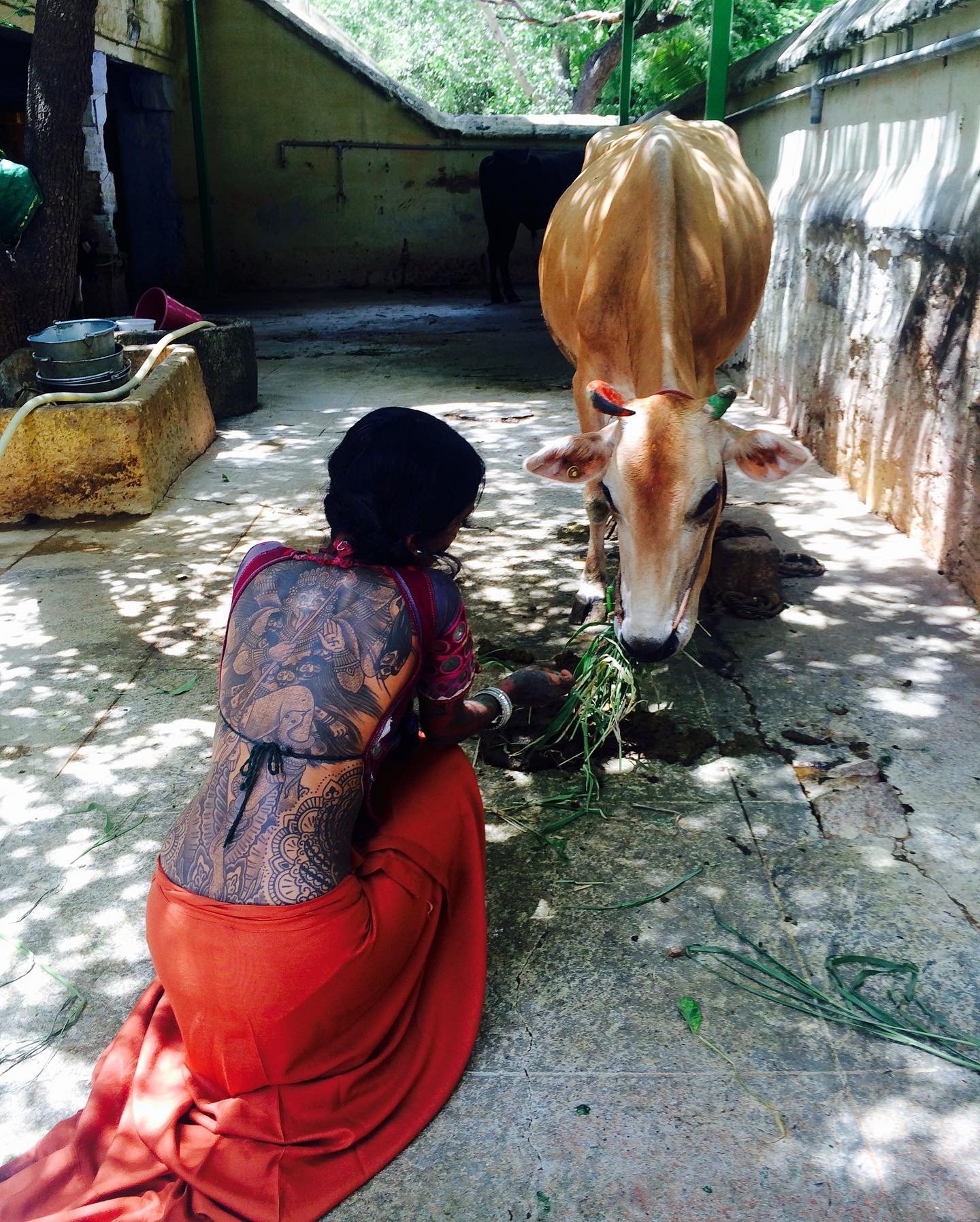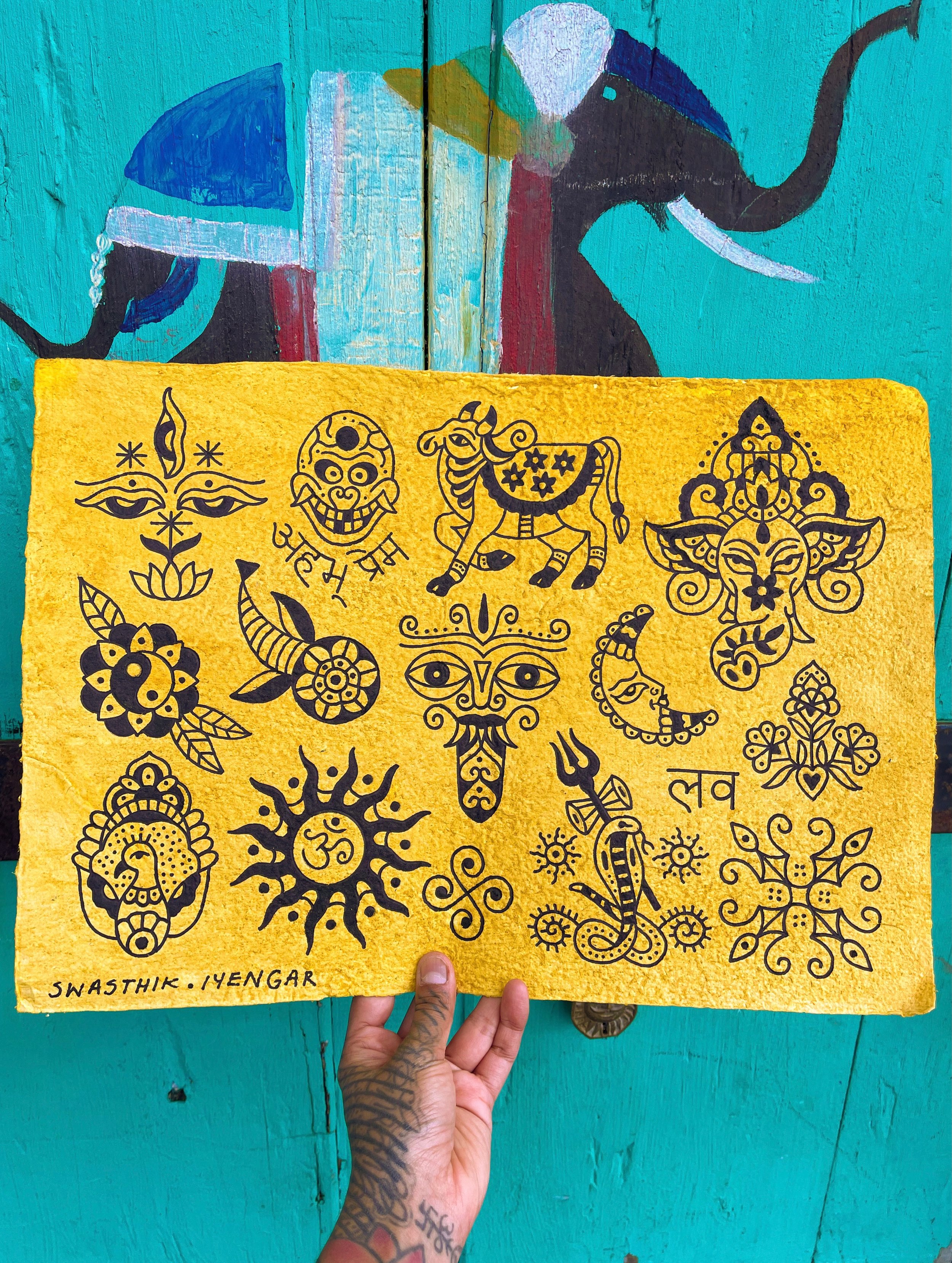The Journey of Indian Street Tattoos with Swasthik Iyengar AKA Gunga Ma
Come on a story-telling journey about the beauty of street tattooing in South India & get a flash tattoo done by Gunga Ma in Bangalore on October 30th 2022 🌸
Image: Portrait of Swasthik Iyengar
Kalia Vanakkum friends my name is Swasthik Iyengar, and I am a tattooist of Indian origin about to take you all on a story telling journey about the beauty of street tattooing in South India. Since there is a vast amount of information about tattooing pertaining to specific areas/tribes and people of India, I have decided to spread small insight into street tattooing that occurs in South India.
I found centring on this aspect of tattooing within the South Indian region was important in explaining the inspiration I gain for my own practice which then also reflects the tattoo designs I have created for my flash day with the wonderful No Border Shop on October the 30th.
Artwork by Swasthik Iyengar
Before I take you all on this special journey, it is very important to highlight that the information I have obtained is based on my own research, interactions with local artists in South India as well as my own experiences growing up with my family. Furthermore, it is crucial to distinguish that there are many forms of tattooing in South India whereby, giving just a general overview would not honour specific people and specific practices. As such, I have decided to provide a small insight on the beautiful Koritha tattoo artists and the current artists commonly tattooing on the roadsides of South India near temples.
Kollam tattoos:
As a sat on the pavement at 5am watching my Patti create large and beautiful grid patterns in front of our house, I stared at how meticulously her hand moved from one end to the other, creating long lines made of rice flour. I noticed the only time she took a break was when a lined was linked to another and she had to get more rice flour from the wooden bucket. I watched her perform this sacred ritual for years and later learnt that this artform was known as kolam.
Image: A type of Kolam Rangoli
Kolam is traditional decorative art that is composed of geometric lines, curves, loops drawn around a grid pattern of dots with ground powder. It is widely practiced by women but in my travels more recently, I have also seen men compose Kolam patterns. Kolam was drawn on house entrances to bring in good energy and luck represented by Goddess Lakshmi. Folklore mandated that the lines must be completed symbolically to prevent evil spirits from entering the inside of the shapes.
In southern India, kolam tattoo designs were tattooed by women on bodies to keep people safe and secure until they reunified with the dead ancestors in the afterlife. The women who performed these sacred tattoo markings called pachakutharathu were called Korathi tattoo artists. It was believed that women being mothers harnessed all prevailing compassion necessary to overcome evil spirts, hence their hands held this compassion to heal when they commenced the tattooing ritual.
Image: Swasthik Iyengar with her grandmother
Image: A tattoo done by Swasthi’s grandmother
Traditionally, the tattooing was executed using traditional stick and poke instruments whereby the ink was made from ground seeds/nuts and ash through a ritual which was necessary in creating a positive experience and relieving pain during the tattooing procedure. Amongst the Korathi tattooists, also was the Toda tribe of South India. To women of the Today tribe of South India did tremendous healing from tattooing their hands, calves and shins with the similar geometric lines in kolam used in their cross stich. Unlike to Korathi tattooists, the Toda Tribe women achieved beautiful and powerful body markings by making cuts on the body and inserting soot under the skin. However, a similarity shared between the kolam tattooists and Toda Tribe women was the usage of sacred symbols/tattoos to protect people from evil spirits.
Artwork by Swasthik Iyengar
With archaeologists and anthropologists having done a tremendous job in unearthing the stories of the past, and the lifestyles of our great ancestors, we have learned that boldness, beauty, and expressiveness was never a new concept. If anything, women back then showcased immense bravery whilst facing prejudice from people in the outside who demonized tattooing. These women did this was as much grace and power, they could collectively bring together through their beautiful ritualistic practices, necessary in connecting each other back to their ancestorial spirits required to continue their own linage. As a result of facing prejudice, most of these tattooists circulated within their own groups in the villages. Honoring tattooing as a sacred craft means honoring these wonderful tattooists who have shown us that the beauty of permanency and body transformation is seen as armor, keeping us protected and strong in culture.
A stick & poke by Swasthi’s grandmother
Street tattooing/roadside tattooing in India is vastly different to the previously style of tattooing that I shared above. Whilst it has not been around as long as tattooing seen in the tribes, its emergence came from the influence of the West/British soldiers, and still holds significance in India, particularly around the concept of faith and family. Street tattooers use coil machines that are completely battery operated or rotary machines. Street tattooing flourished in India during the 20th century when India was part of the British Raj. Back then, tattoo designs were based of sailor designs such as ships and anchors as solders were getting tattooed in the Bombay docks. Once the British left, tattoo designs started depicting more Hindu mythology such as OM signs, the trisula and Kali Ma faces. The designs were showcased on paper or carved of wooden blocks which were pressed on to the skin with ink. This allowed street tattooers to easily tattoo over the block print template and create a permeant tattoo. Since the designs were Hindu based, street tattooers moved to work near temples whereby devotees wanted to get Hindu symbols permanently tattooed on their skin to express their devotion to God. I found out this information through street tattooers in the Andhra regions during my travels to India in 2019. When I connected with other street tattooers during that time, they stated that with globalization and tattooing trends, a lot of street tattooers seem to also tattoo family names and quotes on people such as husbands’ names and words such as “Love”.
Flash sheet for Bangalore Oct 30th, inspired by Indian street tattoos
Since I commenced a traditional tattoo apprenticeship in Australia and was not only influenced by American traditional tattooing concepts as well as tribal tattooing concepts, I decided to create a street flash sheet of tattoo designs that embodies my inspiration for both. My love for our culture allowed me to create my own designs that celebrated tattooing in South India. I wanted to make this as handmade as possible and created the designs on turmeric-stained handmade Indian paper. I hope this journal entry has given everyone a very small insight into some elements of tattooing in India. Tattooing in India is very deep. There is in fact more information about both kolam and street tattooing, and I hope to share this with you all on our special day on the 30th of October with the beautiful people and community of No Borders Shop.
Before I go, I just wanted to say that I respect and honour our first nation tattooists and artists because they have paved for us and through studying their designs/sacred motifs, I am able to continue the work they did and help connecting us all back to our ancestors, and our land.
Join us at our No Borders Studio in Bangalore, this 30th of October as we have Swasthik Iyengar spend the day with our community and create beautiful flash tattoos on us. Head to our website No Borders Shop to PRE-BOOK your slots.









